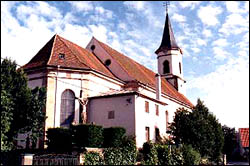| Duttlenheim | |
 | |
| Information | |
| Country | |
|---|---|
| Area | 8,6 km² |
| Population | 2 880 hab. () |
| Density | 334,88 inhab./km² |
| Postal code | 67120 |
| Spindle | UTC 01:00, UTC 02:00 |
| Location | |
 48 ° 31 ′ 32 ″ N 7 ° 33 ′ 59 ″ E | |
| Official site | |
| Touristic site | |
Duttlenheim is a town french located in the Bas-Rhin in Alsace. The village has about 2,812 inhabitants. Its official coat of arms is made up of four quarters. The first quarter is azure in color and contains a bust of a woman without arms. The second represents a stork, it is the coat of arms of the Reich Von Platz. The third quarter represents the cross of the Andlau family, the fourth the coat of arms of the Landsberg family.
Understand
The existence of Duttlenheim is attested for the first time at the end of the 10th century, on the occasion of a donation of goods that the Count di Nordgau made to the Abbey of Altorf. In the XIIIe century, the village is part of the possessions of the bishopric of Strasbourg which gives it as a fiefdom to the Landsberg. In the following century, the bishop attributed part of the locality to the Andlau, and another part to the Sturm of Sturmeck. The share of the latter passed in 1640 to a family from Tyrol, the Reich von Platz. In 1533, the Reformation was introduced in the village, but it returned to the Catholic religion in 1686. During the Revolution, the village was integrated into the canton of Geispolsheim and remained there until 1974. Duttlenheim was always an important village which, in 1861, account 1,577 inhabitants.
To go
Circulate
See
Saint Louis church

This neo-Gothic style church has a facade with a semi-engaged bell tower and a portal with a triangular pediment, a single nave with rectilinear side portals and a recessed polygonal choir animated by chains. The building can be attributed to the architect Desbordes, principal inspector of Bridges and Roads, who in 1773-1775 established plans and specifications for the original project, modified during execution. The number of spans of the nave was increased from four to six, and the portal with columns and low pediment gave way to a more severe entrance.
On one of the facades of the parish church, facing south, is installed a sundial carved in a square slab. Covered at one time with a layer of plaster, it saw the light again in 1967, when the wall covering was being renovated. All the figures are oriented towards the center, probably for the sake of harmony on the part of the creative craftsman.
The high altar is dated XVIIIe century. Framed by four semi-engaged Corinthian columns, the altar painting dated 1838 is the work of an anonymous painter. The canvas shows the patron of the church kneeling, praying in front of an altar. The mantle adorned with fleur-de-lis and the royal attributes placed at its feet recall that Saint Louis was king of France from 1226. He died of the plague in 1270 at the gates of Tunis, during the Eighth Crusade.
The organ of Duttlenheim comes from the workshops of Seltz. He is transformed by Koulen and Kriess, then by the Steinmetz brothers during the XIXe and XXe centuries. Also very redesigned, the oak sideboard has side parts made in 1920. Despite these works, the organ remains a quality instrument, including four faceplates and three turrets topped with urns in semi-relief.
The calvary
The village has several crosses of XVIIIe and XIXe century, including this baroque T-shaped Calvary, located on the avenue du Général de Gaulle. Restored during the 19th centurye century, it was erected on the initiative of two women, Anna and Maria, and features the three usual protagonists, Christ on the cross, the Virgin and Saint John, the latter two being a little rough.
The private chapel
Following the birth of three deaf and dumb children, a village family takes an oath to build a chapel if a healthy child is born. The wish comes true, and the father then has this private chapel built. He himself went to look for the necessary materials to build it in 1808.
Old washhouse
This traditional 19th century wash housee century is sheltered by a gable roof, supported by eight pillars. At the edge of the water there are nine pitches, called Waschbretsche, reserved for washerwomen who beat the laundry there. Like many constructions of the same type, it was high at a time when municipalities had greater budgetary autonomy, and when the population became aware of the importance of personal hygiene.
Well
Many wells are scattered throughout the village. This is located in the impasse des Francs-Bourgeois, and consists of a massive tank transformed into a flower box. The wooden winch around which the chain is wound is sheltered by a saddleback roof, covered with Alsatian tiles, say: Biberschwänz.
Make
Buy
Eat
- Nice view 2, station district,
 33 3 88 47 80 86, email: [email protected] – Brasserie, Traditional Cuisine and breakfast. 15 place settings. The room is accessible to people with reduced mobility.
33 3 88 47 80 86, email: [email protected] – Brasserie, Traditional Cuisine and breakfast. 15 place settings. The room is accessible to people with reduced mobility. - the Golden Crown 9, rue du Général Leclerc,
 33 3 88 50 81 26
33 3 88 50 81 26 - the golden cross 44, rue du Général de Gaulle,
 33 3 88 49 10 60
33 3 88 49 10 60
Housing
- Furnished accommodation from Mrs Kathia Monsch 42, rue de la Gare – Maisonette in large interior courtyard, separate entrance, lounge area with sofa bed for 2 people, bedroom with double bed, mezzanine with sleeping space for 2 people.
